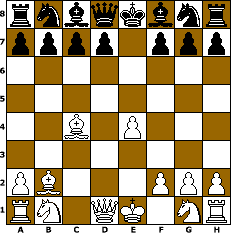The Danish Gambit is a chess opening that begins with the moves
- 1.e4 e5
- 2.d4 exd5
- 3.c3
Although it may have been known earlier, Danish player Martin From essayed the gambit in an 1867 Paris tournament and he is usually given credit for with the opening. The Danish gambit was popular with masters of the attack including Alekhine, Marshall, Blackburne, and Mieses, but as Black´s defenses improved it lost favor in the 1920s. Today it is rarely played in top-level chess.
White will sacrifice one or two pawns for the sake of rapid development and the attack. With care, Black can accept one or both pawns safely, or simply decline the gambit altogether with good chances.
Main variations

The Danish Gambit is a variation of the Center Game that is important enough to be treated on its own.
It is C21 in the ECO classification.
After 1.e4 e5 2.d4 exd4 3.c3, Black can safely decline the gambit with 3...d3 or 3...d5 (Sörensen Defense). If Black enters the Danish Gambit Accepted with with 3...dxc3, the main possibilities are
- 4.Nxc3 (Half Danish)
- 4.Bc4 (main line)
Alekhine recommended that White play the Half Danish by playing 4.Nxc3.
This line often transposes into the Göring Gambit of the Scotch Game.
White can instead offer a second pawn with 4.Bc4.
The second pawn can be safely declined by transposing into the Scotch Gambit.
Accepting the pawn allows White´s two bishops to rake the Black kingside after 4...cxb2 5.Bxb2.
White will often follow up with Qb3 if possible, applying pressure on Black´s b7 and f7 squares. Combined with White´s long diagonal pressure on g7, this can make it difficult for Black to develop his bishops.
Schlechter found the most reliable defense for Black; by returning one of the pawns with 5...d5 Black gains time to complete development. After 6.Bxd5 Nf6 7.Bxf7+ Kxf7 8.Qxd8 Bb5+ 9.Qd2 Bxd2+ 10.Nxd2 c5, Black regains the queen and the queenside majority gives Black the advantage in the endgame. If White instead plays 6.exd5, his light-square bishop is blocked and after 6...Nf6 7.Nc3 Bd6 Black can complete development relatively easily.
References
- Lutes, W. John (1992). Danish Gambit. Chess Enterprises. ISBN 0-945470-19-3.
|
